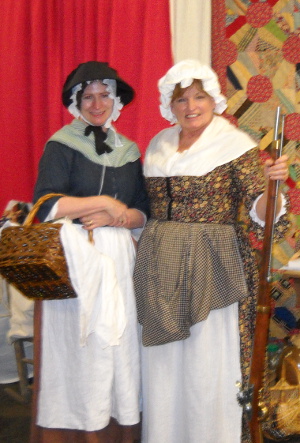If you’re like me, when you picture the ladies of Lexington, often you see them costumed like Ma Ingalls on Little House on the Prairie. Obviously, there are many similarities.
Remember, the Colonial ladies were used to buying much of their cloth from the stores in Boston and the like. But, when British goods were boycotted the women relearned the skills necessary to spin and weave their own cloth. They wore homespun linen (from flax) and wool for the most part. Print fabric was rare. Striped fabric was a bit less rare. But mostly they wore solid colors that they could dye themselves, blue, brown, etc.

We’ll start with the shift. This was the “under-est” piece of a ladies attire. It was likely made from linen and it was a simple one-piece garment that ladies slept in and then put other pieces over in the morning. Ladies generally had two shifts. They would actually bathe in their shift, washing it along with themselves. Then they would hang that shift to dry and switch to their clean one – probably for Sunday meeting.
Pockets attached to a belt were tied on next.
Next came stays if she wore them. These were not to cinch in the waistline as much as to give back support.
Over the shift went petticoats – we would likely call them skirts. The number of petticoats was determined by the weather. The petticoats again tied on and left room for expansion when pregnant. Also, slits in the sides allowed our lady to reach into her pockets.
A “cape” or neckerchief was worn around the neck. This was more like a large scarf tied in front. This was worn for modesty and to protect against sunburn.
Over the petticoats went the gown or a short-gown (like a shirt). Some gowns were open in the front, showing off the petticoats beneath.
All these clothes were tied on either with sashes like on an apron or with laces. There were no buttons or zippers. Some women held their jackets or gowns closed with straight pins.
Aprons might be worn as well, to protect the skirt and served for carrying, as a towel or a hotpad.
In addition, women wore woolen stockings and shoes. They wore mopcaps, white caps that covered their hair and kept it “clean” – sometimes these were lacy and sometimes very plain. On top of the mop caps, ladies sometimes wore silk or straw bonnets.
If you have time, here’s a wonderful video that shows our Colonial lady puts on her layers of clothes. It is followed by dressing her husband.
